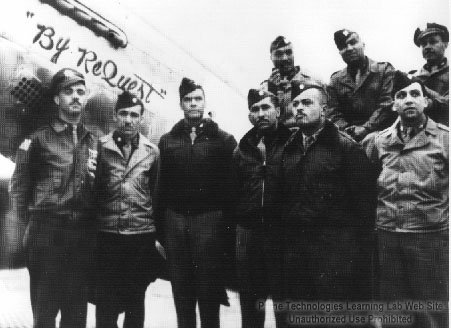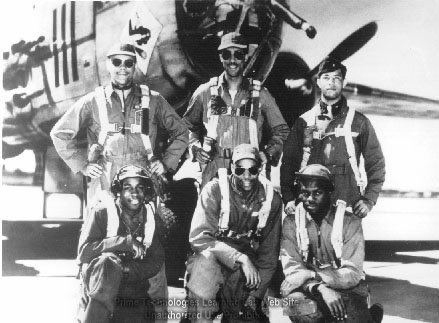 |
|||||
| Home | Research | For Teachers | HISTORY Level 1 Level 2 Level 3 |
PRINCIPLES Level 1 Level 2 Level 3 |
CAREER Level 1 Level 2 Level 3 |
| Gallery | Hot Links | What's New! | |||
| Web Administration and Tools | |||||
 |
|||||
| Home | Research | For Teachers | HISTORY Level 1 Level 2 Level 3 |
PRINCIPLES Level 1 Level 2 Level 3 |
CAREER Level 1 Level 2 Level 3 |
| Gallery | Hot Links | What's New! | |||
| Web Administration and Tools | |||||
 |
| For more information on the Tuskegee Airmen,
visit the Blacks In Aviation section of the ALLSTAR Learning Laboratory This photo is used with permission. Unauthorized use is prohibited. |
Although a rigid pattern of racial segregation prevailed in the United States during World War II, nearly 1,000 Black military aviators were trained at an isolated complex near the town of Tuskegee, Alabama, and at Tuskegee Institute. As a result of this “Tuskegee Experiment” 450 Black fighter pilots under the command of Col. Benjamin O. Davis, Jr. Fought in the aerial war over North Africa, Sicily, and Europe, flying, in succession, P-40, P-39, P-47, and P-51 type aircraft. These gallant men flew 15,553 sorties completing 1,578 missions with the 12th Tactical, and the 15th Strategic, U.S. Army Air Force. Col. Davis later became the first Black general in the U.S. Air Force and rose to the rank of Lt. General.
Known as the Schwartze Vogelmenshen (Black Birdmen) by the Germans who both feared and respected them. The were also known as the `Red Tail Angels' by white bomber crews because of their red paint on their tail assemblies and their reputation for not losing bombers to enemy fighters as they provided fighter escort over strategic targets in Europe.
The 99th Fighter Squadron then merged with three other Black squadrons: the 100th; the 301st, and; the 302nd to form the 332nd Fighter Group, comprising the largest fighter unit in the 15th Air Force. From Italian bases they also destroyed enemy rail traffic, coastal surveillance stations, and hundreds of vehicles on air-to-ground strafing missions.
Sixty-six of these pilots were killed in aerial combat while another thirty-two were either forced down or shot down and captured as prisoners of war. The Airmen returned home with over 150 decorations including the Distinguished Flying Cross, Legion of Merit, and the Red Star of Yugoslavia.
Another group, trained for medium bombardment duty was joined by the 332nd combat returnees to form the 447th Composite Fighter-Bomber Group. Although they never entered combat because of the surrender of Germany and Japan in 1945, the 477th's demands for parity and recognition as competent military professionals combined with the superb wartime record of the 99th and the 332nd led to review of the U.S. War Department's racial policies.
For every Black pilot there were ten other civilian or military Black men and women on ground support duty. Many of them remained in the military during the post-World War II era and spearheaded the integration of the armed services with the integration into the U.S. Air Force in 1949. Thus the “Tuskegee Experiment” achieved success rather than the expected failure. Three of these pioneers rose to flag rank: the late General Daniel “Chappie” James, our nation's first Black Four-star General; Lt. General Benjamin O. Davis, Jr. USAF Ret., and; Major General Lucius Theus, USAF, Ret.
 |
| For more information on the Tuskegee Airmen,
visit the Blacks In Aviation section of the ALLSTAR Learning Laboratory This photo is used with permission. Unauthorized use is prohibited. |
Three Tuskegee Airmen, retired USAF Colonels, flew combat missions as fighter pilots in WW II, the Korean War, and the Vietnam War: Charles Cooper; Hannibal Cox, and; Charles McGee. Three others flew combat in Vietnam in other type aircraft and retired as Lt. Colonels, USAF. They are: John “Mr. Death” Whitehead; Bill Holloman, and; George Hardy. Many of them returned to civilian life and earned positions of leadership and respect in all walks of life.
In 1972 the Tuskegee Airman, Inc. was founded as a non-military, non-profit entity. Their primary motivation is to inspire young Americans to participate in our nation's society and democratic process.
Thirty-seven chapters are located in major cities throughout the United States.
Membership is made up, principally, of veterans of the armed forces and active duty
personnel from all branches of the military. It also includes a growing number of
civilians who demonstrate sincere interest in helping the organization achieve its goals
and objectives.
To inquire about membership in a chapter in your area, write to: Tuskegee Airmen, Inc., Box 54036, Washington, DC 20032-0236.
The text for the Tuskegee Airmen is provided by Jim Thompson, author of African-American Heroes.
For pictures and more information on the Tuskegee Airmen, go to the ALLSTAR Learning Laboratory's Blacks in Aviation section.
Send all comments to ![]() aeromaster@eng.fiu.edu
aeromaster@eng.fiu.edu
© 1995-98 ALLSTAR Network. All rights reserved worldwide.
Updated: 17 February, 1999